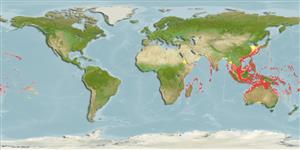Actinoptérygiens (poissons à nageoires rayonnées) >
Perciformes (Perch-likes) >
Lutjanidae (Snappers) > Lutjaninae
Etymology: Lutjanus: Malay, ikan lutjan, name of a fish.
Environnement / Climat / Gamme
Écologie
; marin récifal; profondeur 1 - 150 m (Ref. 9710). Tropical, preferred 28°C (Ref. 107945); 35°N - 33°S, 31°E - 134°W (Ref. 55)
Indo-Pacific: Red Sea and East Africa to the Line and Society islands, north to southern Japan, south to Australia.
Length at first maturity / Taille / Poids / Âge
Maturity: Lm 21.5 range ? - ? cm
Max length : 50.0 cm TL mâle / non sexé; (Ref. 55); common length : 45.0 cm TL mâle / non sexé; (Ref. 5450); âge max. reporté: 18 années (Ref. 2293)
Épines dorsales (Total): 10; Rayons mous dorsaux (Total): 13-14; Épines anales 3; Rayons mous anaux: 8.
Adults mainly inhabit coral reefs, sometimes forming large aggregations, which are mostly stationary during the day. Juveniles occur in seagrass beds, also in mixed sand and coral habitats of shallow sheltered reefs (Ref. 1602). Sub-adults commonly form very large schools that are stationary or drift slowly along slopes during the day. Large individuals along coastal slopes at moderate depths (Ref. 48635). Benthopelagic (Ref. 58302). Feed on fishes, and a variety of invertebrates including shrimps, crabs, lobsters, stomatopods, cephalopods, echinoderms and ophiuroids (Ref. 55).
Off East Africa spawning occurs mainly during spring and summer.
Allen, G.R., 1985. FAO Species Catalogue. Vol. 6. Snappers of the world. An annotated and illustrated catalogue of lutjanid species known to date. FAO Fish. Synop. 125(6):208 p. Rome: FAO. (Ref. 55)
Statut dans la liste rouge de l'IUCN (Ref. 115185)
CITES (Ref. 94142)
Not Evaluated
Menace pour l'homme
Reports of ciguatera poisoning (Ref. 9710)
Utilisations par l'homme
Can't connect to MySQL database (fbapp). Errorcode: Too many connections
